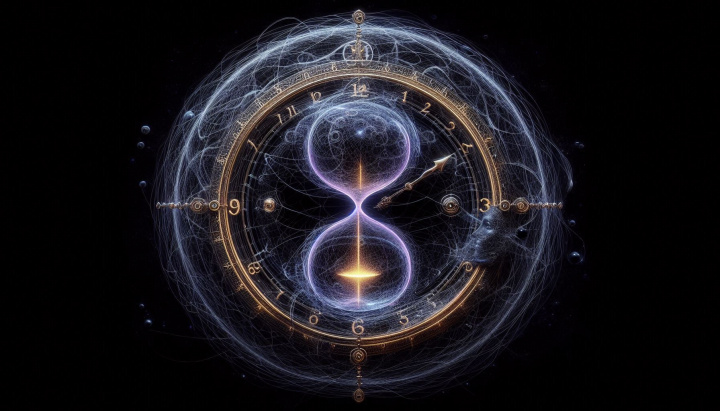Quantum Experiment Measures Apparent -Negative Time Delay- for Photons
Scientists at the University of Toronto have made a startling observation in the realm of quantum physics that challenges conventional notions of how we measure time durations at the quantum scale. In an experiment studying the interaction of photons with an ultracold cloud of atoms, researchers observed what they termed an apparent "negative time delay" or "negative dwell time." Under specific conditions, photons seemed to exit the atomic cloud faster than expected based on their entry, leading to a calculated negative duration for their interaction.

This discovery, detailed in a preprint paper submitted for peer review and reported by The Independent, presents a fascinating puzzle regarding the concept of time in quantum interactions, rather than suggesting time itself flows backward.
Details of the Quantum Experiment
Researchers, including those from Trinity College affiliated with the University of Toronto, directed photons through a cloud of ultracold rubidium atoms to study the process of atomic excitation. Typically, when photons interact with atoms in such a medium, a time delay (often characterized by "group delay" or "dwell time") is observed – the photons take a short amount of time to traverse the cloud due to interactions. However, after meticulously studying photon behavior over seven years, the team encountered extraordinary results under certain experimental conditions:
- Some photons were detected exiting the cloud associated with a calculated interaction time that was negative – specifically, a negative "dwell time" of up to -0.47 milliseconds was reported in their preprint.
- This negative value arose because the peak of the photon wave packet appeared at the exit earlier than would be expected based on the speed of light in vacuum and the cloud's length, creating the illusion that they left before they had finished interacting.
- This observation fundamentally challenges how we interpret interaction times derived from quantum measurements and raises intriguing questions about the nature of time-related metrics at the quantum scale.
The Unexpected Behavior of Photons
The unusual photon behavior observed in the experiment points towards phenomena distinct from simple classical interactions. Key observations included:
- The calculation yielding negative interaction times, suggesting photons effectively "skipped ahead" in time relative to the expected delay.
- Instances where atoms became excited even when the transmitted photon seemed not to have interacted significantly (a known quantum phenomenon related to interaction-free measurement concepts).
- Photons being absorbed and then re-emitted almost instantaneously under conditions leading to the negative delay effect.
Theoretical physicist Howard Wiseman (Griffith University, not directly involved but commenting on related concepts) suggests such phenomena often stem from the probabilistic nature of quantum mechanics. Photon absorption and emission follow probabilistic models. In some quantum scenarios, particularly those involving interference and superposition, the average or most probable outcome of a measurement can yield counter-intuitive results, like an apparent negative time delay. The Toronto paper suggests that the quantum superposition principle is key: particles can exist in multiple states simultaneously, experiencing different potential outcomes. Crucially, they propose that even the measuring apparatus itself can enter a superposition, simultaneously registering different interaction possibilities. This quantum fuzziness, when measurements are performed and averaged, can manifest as a negative value for the calculated interaction time, highlighting the counter-intuitive nature of quantum measurement.
Interpreting "Negative Time Delay"
While the concept of a "negative time delay" or "negative dwell time" challenges our everyday intuition, it crucially **does not imply that time itself flows backward** or that causality is violated (allowing effect before cause). Instead, it sheds light on the peculiar nature of quantum measurements and their probabilistic outcomes when defining interaction durations.
The negative delay suggests that a hypothetical "quantum clock," designed to measure the duration based on, say, the atom's excitation process, might appear to run backward under these specific quantum interference conditions. This effect arises from the probabilistic nature of quantum interactions where photons and atoms exist in superpositions. The measured negative values are a consequence of how interaction time is *defined and measured* in this quantum context, involving interference between different probability amplitudes, rather than a fundamental reversal of time's arrow.
These results underscore the limitations of applying classical concepts of time duration directly to quantum systems. They suggest that new frameworks or refined interpretations might be needed to fully grasp temporal behavior at the quantum level, particularly when dealing with wave packet reshaping and interference.
While these findings won't change our macroscopic perception of time flowing forward, they open new avenues for investigating the nature of time in quantum mechanics and could lead to refined interpretations of quantum optical experiments and potentially new quantum measurement techniques.
Research Status and Scientific Community Reactions
The study describing this quantum phenomenon, titled "Experimental evidence that a photon can spend negative time in an atomic cloud," is currently undergoing peer review (available as a preprint on arXiv). Despite its preliminary status, the research has generated significant interest and surprise within the scientific community.
Aephraim Steinberg, an experimental quantum physicist at the University of Toronto and a lead author on the paper, shared on social media that the results might seem "crazy" at first glance. Josiah Sinclair, another researcher involved, expressed that the team was "totally surprised" by their findings. The scientific community's reaction is one of cautious intrigue, acknowledging the need for rigorous peer review and independent replication to confirm such extraordinary claims and fully understand their implications.
While the discovery is fascinating, experts emphasize that these results pertain to the intricacies of quantum measurement and wave packet dynamics. They do not overturn our fundamental understanding of macroscopic time but highlight the need for careful interpretation when discussing temporal concepts in the quantum realm.





